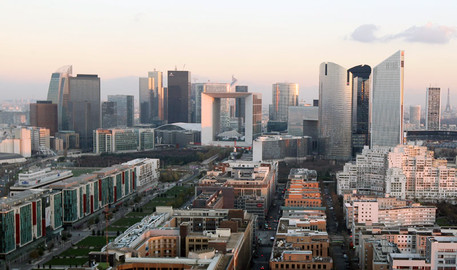Here is a list of the events scheduled for Wednesday, July 8th!
The archaeology of contact between China and Southeast Asia between the mid-1st millennium BC and the mid-1st millennium AD
Room: Salle du Lesc F308 MAE
Time: 9:30
Chairs: Francis Allard, Aude Favereau and Sachipan Srikanlaya
Abstract: The wide distribution of China-related artefacts dating from c. 500 BC to 500 AD unearthed at sites in Southeast Asia has highlighted the existence of long-distance contact between China and Southeast Asia. This panel aims at understanding the networks and populations involved in this interaction.
- Aspects of the iconography of Dong Son drums: a sino-vietnamese conflict? (Pierre Baptiste)
- Han-related artifacts found in central and southern Vietnam: date, distribution and diversity (Mariko Yamagata)
- Luxuries, prestige goods, and other things (Brigitte Borell)
- Re-examinnation of the classification and chronology to specimens of later half of Heger I type bronze drums in East and Southeast Asia (Kanji Tawara)
- Reaching ‘the edge of the Southern Wilderness’: the road network of the Lingnan-Bac Bo region during the Qin and Han Dynasties (Michele Demandt)
- The ancient Shu culture and the civilization in Southeast Asia (Yu Duan and Yiqing Zou)
- The exchange and use of Bronze Thaps (Bucket-Shaped Bronze Vessels) in the Bac Bo and Lingnan regions from the 3rd century BCE to the 3rd century CE (Weiyan Wei)
- The maritime cultural relations during the Han Dynasty of China: the linking network between South China and Southeast Asia (Sachipan Srikanlaya)
- The southern maritime route and the Nanyue Kingdom: representation, transformation and impact (Francis Allard)
Recent advances in the study of the Neolithic, Bronze and Iron Ages of mainland Southeast Asia
Room: Salle des Conférences bât B
Time: 9:30
Chairs: Charles Higham
Abstract: This panel invites papers that report on later prehistory with reference to the results of recent fieldwork that reflect new information on the origins of cultural changes, migratory patterns, the impacts of new technologies, social organisation, subsistence and demography
- Kumphawapi revisited: a synthesis of Holocene environmental and climatic changes for NE Thailand (Barbara Wohlfarth, Sakonvan Chawchai, Yamoah Kweku Kyei Afrifa, Minna Valiranta, Rienk Smittenberg, Maarten Blaauw and Paula Reimer)
- Satellite remote sensing for the investigation of late prehistoric/early historic sites in NW Cambodia (Kasper Hanus, Emilia Smagur and Wojciech Ostrowski)
- Non Ban Jak: a late Iron Age town in Northeast Thailand (Charles Higham and Dougald O’Reilly)
- Dismemberment and other specific funerary practices: new data from the Early Neolithic site of Ding si shan (South China) (Jennifer Kerner and Fajun Li)
- Kok Treas: Iron Age necropolis site at Banteay Chhmar (Heng Than)
- Clay stamps deciphered: impressions of long-distance interaction between Mainland Southeast Asia and Eurasia (Judith Cameron)
Southeast Asian epigraphy: new discoveries and current research
Room: Salle du conseil 4th floor MAE
Time: 9:30
Chairs: Christian Bauer
Abstract: Participants of the panel on Southeast Asian epigraphy will report on current field, museum, and archival research on inscriptions as well as their documentation.
- It’s BED time! Towards a new list of inscriptions from the Bagan period (Tilman Frasch)
- Inscriptions from Northern Thailand in Dhamma Script (16th to 18th century CE) (Marek Buchmann)
- Newly discovered Mon inscribed images and slabs from Burma and Thailand (Christian Bauer)
- Isan Epigraphy from 6th to 12th century: diversity and chronology (Daoruang Wittayarat)
Women and Buddhism in the arts of Southeast Asia
Room: Salle de cours rez-de-jardin MAE
Time: 9:30
Chairs: Angela Chiu
Abstract: This panel explores the roles of the female and attitudes towards the female as reflected in Buddhist art in Southeast Asia.
- A woman, a monk and a melon: a Northern Thai manuscript on the ‘Emerald Buddha and its female donor’ (Angela Chiu)
- As fickle as the sea: Manimekhala in Thai art and lore (Jessica Patterson)
- Fifty-two Bhikkhuni images: Thepthidaram temple for Rama III’s daughter (Pattaratorn Chirapravati)
- Maddī from the Vessantara Jātaka: devoted wife and mother (Danel Tuy)
- The iconography and iconology of Prajnaparamita (Pia Conti and Wibke Lobo)
- Women weavers of sazigyo (manuscript binding tapes) (Ralph Isaacs)
Towards an ethno-archaeological framework for sea nomads in Southeast Asia?
Room: Salle 211 G MAE
Time: 9:30
Chairs: Bérénice Bellina-Pryce, Roger Blench and Jean-Christophe Galipaud
Abstract: This panel wishes to investigate the motivations, adaptations and role of Southeast sea nomadism in the past and the potential to build an ethnoarchaeological frames of reference to better interpret sea peoples’ contributions to archaeological and historical reconstruction.
- Austronesian westward expansion: the settlement of Madagascar by Indonesian sea nomad groups (Pradiptajati Kusuma, Francois-Xavier Ricaut, Murray Cox and Thierry Letellier)
- Diaspora Bajo: origin and transformation (Charles Illouz)
- Don’t throw out the Nusantao baby with the bathwater (David Bulbeck)
- How far can we read the practice of sea nomadism into the past? (Roger Blench)
- Nomads story and history, a new vision for archeologists (Jacques Ivanoff)
- Sea people, coastal territories and cultural interactions? Tetum Terik and Bunak in the Suai district on the south coast of Timor-Leste (Dominique Guillaud, Brunna Crespi and Jean-Christophe Galipaud)
- The archaeological heritage of ancient human settlement dwelling in South China Sea (Chunming Wu)
Angkor beyond temples, a countercurrent archaeology
Room: Salle de cours rez-de-jardin MAE
Time: 9:30
Chairs: Jean-Baptiste Chevance and Pierre Bâty
Abstract: Everyday life and Man’s place in Angkorian society, far from an archeology of temples and elites.
- In or out? Reflexions on temple enclosures and settlements (Christophe Pottier)
- Settlement in the suburbs of Angkor: organization and presence in the territory (Pierre Bâty)
- Axis, plots and sites: an unknown urban network in Phnom Kulen (Jean-Baptiste Chevance)
- New approaches to the remote sensing of Angkorian landscapes (Damian Evans)
- Occupation and spatial planning around Vat Phu (Michel Lorrillard)
- Archeological surveys at Choeung-Ek, Cambodia (Michel Pichon)
Excursion(s)
Time: 14:00 – Afternoon/Evening

